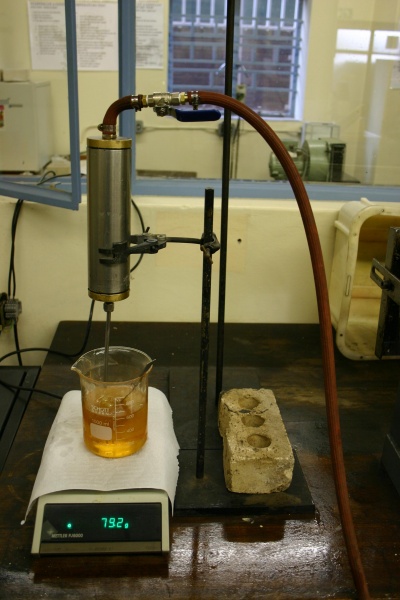Difference between revisions of "T06 US Steel Mobility Test Rig"
(Created page with 'The Mettler Mass Comparator in the Tribology Lab The Mettler Coparator Balance is not a normal mass meter. It is used for measur...') |
(→Test Procedure) |
||
| (3 intermediate revisions by 2 users not shown) | |||
| Line 1: | Line 1: | ||
| − | [[File: | + | [[File:US_Steel_Mobility.JPG|400px|right|thumb|The US Steel Mobility Test Rig in the Tribology Lab]] |
| − | + | ||
== Documentation == | == Documentation == | ||
| − | |||
| − | |||
| − | |||
| − | == | + | == Test Procedure == |
| − | + | ||
| − | + | ||
| − | + | ||
| − | + | Download the [ftp://anonymous@ragnarok.up.ac.za/publicftp/lab/Tribology/US%20Steel%20Mobility%20Test%20Rig/BE%40UP%20Tribology%20lab%20Test%20Descriptions%20-%20%28US%20Steel%20Mobility%29.pdf US Steel Grease Mobility Test Procedure] | |
| + | |||
| + | Grease mobility is a measure of the resistance to flow under prescribed conditions. The measure of resistance to grease flow at a prescribed pressure and temperature predicates the pumpability characteristics of lubricants under low temperature operating conditions. | ||
| + | |||
| + | The test sample is placed in a high pressure container which is connected to a nitrogen cylinder fitted with a pressure regulator. A capillary (6 inches long (152,4 mm) with a 0.150 inches inside diameter (3,81 mm)) is fitted to the grease container. | ||
| + | |||
| + | A delivery pressure of 150 psi (1 034 kPa) is applied by means of the nitrogen in the nitrogen cylinder. Sufficient grease is collected for a measured amount of time to calculate the mobility in grams per second. | ||
| + | |||
| + | Tests at low temperatures are conducted by placing the loaded grease container in a refrigerator overnight. Tests are carried out at -15, -5, 0, 5, 10 and 20°C. | ||
Latest revision as of 15:58, 26 July 2010
Documentation
Test Procedure
Download the US Steel Grease Mobility Test Procedure
Grease mobility is a measure of the resistance to flow under prescribed conditions. The measure of resistance to grease flow at a prescribed pressure and temperature predicates the pumpability characteristics of lubricants under low temperature operating conditions.
The test sample is placed in a high pressure container which is connected to a nitrogen cylinder fitted with a pressure regulator. A capillary (6 inches long (152,4 mm) with a 0.150 inches inside diameter (3,81 mm)) is fitted to the grease container.
A delivery pressure of 150 psi (1 034 kPa) is applied by means of the nitrogen in the nitrogen cylinder. Sufficient grease is collected for a measured amount of time to calculate the mobility in grams per second.
Tests at low temperatures are conducted by placing the loaded grease container in a refrigerator overnight. Tests are carried out at -15, -5, 0, 5, 10 and 20°C.
